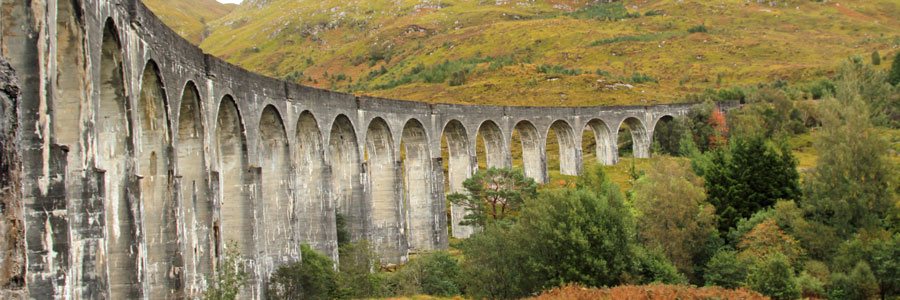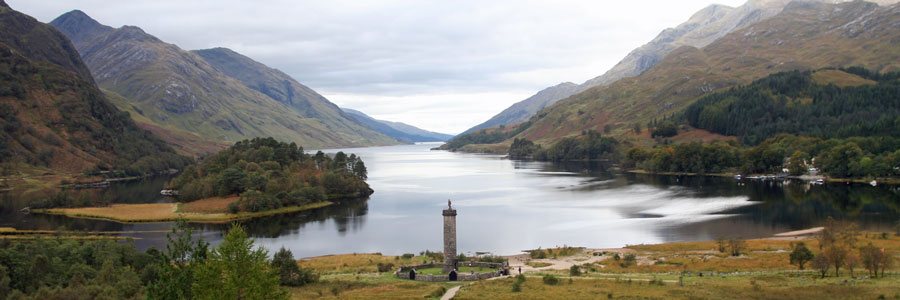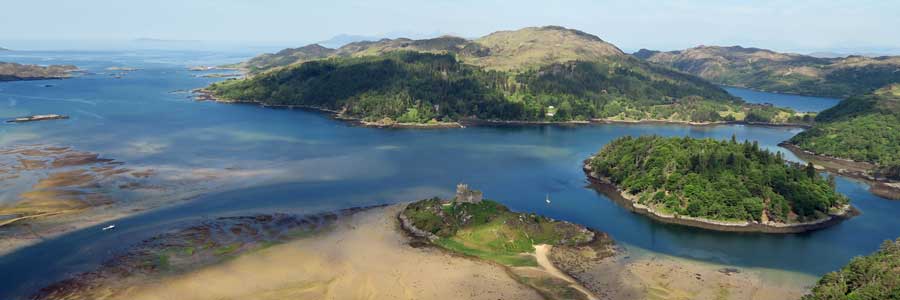 Moidart, Ardnamurchan, Morvern, Morar and Arisaig support a diversity of grassland habitat, ranging from acidic hill grasslands to species rich calcareous grasslands, including the unique coastal shell-sand machair characteristic of the Western Highlands. In spring and summer, both hay and wet meadows abound with orchids, including spotted, marsh, butterfly and fragrant orchids. Other wild flowers, such as yellow rattle (Rhinanthus minor), harebells (Campanula spp), bird’s foot trefoil (Lotus corniculatus), vetches (Vicia spp), buttercups (Ranunculus spp), red clover (Trifolium pratense), and ragged robin (Lychnis flos- cuculi) and devils' bit scabious (Succisa pratensis) in the wetter areas, give characteristic hues to the different types of grassland according to the season.
Moidart, Ardnamurchan, Morvern, Morar and Arisaig support a diversity of grassland habitat, ranging from acidic hill grasslands to species rich calcareous grasslands, including the unique coastal shell-sand machair characteristic of the Western Highlands. In spring and summer, both hay and wet meadows abound with orchids, including spotted, marsh, butterfly and fragrant orchids. Other wild flowers, such as yellow rattle (Rhinanthus minor), harebells (Campanula spp), bird’s foot trefoil (Lotus corniculatus), vetches (Vicia spp), buttercups (Ranunculus spp), red clover (Trifolium pratense), and ragged robin (Lychnis flos- cuculi) and devils' bit scabious (Succisa pratensis) in the wetter areas, give characteristic hues to the different types of grassland according to the season.
The calcareous coastal machair of Sanna in the Ardnamurchan and Arisaig in Morar are of local importance to the region. This rare coastal grassland habitat formed from inland blown sand and shell fragments is largely restricted to, and best represented in, the Hebridean Islands. Machair supports nationally and internationally important populations of corn-buntings, corncrakes, chough and lapwing. Rare invertebrates include the belted beauty moth (Lycia zonaria), the northern colletes (Colletes floralis) and the great yellow bumblebee (Bombus distinguendus), as well as the slender Scotch burnet(Zygaena loti) (found on Mull), are also associated with this habitat. In places, machair merges into dry coastal heath consisting of heather (Calluna vulgaris), bell heather (Erica cinerea), bilberry (Vaccinium myrtillus), western gorse (Ulex europaeus) with tormentil (Potentilla tormentilla), Festuca spp. and other heathland grass species.
 Fragments of salt marsh can be found in Kilchoan, Glenborrodale, Salen and Kentra Bay in the Ardnamurchan, as well as sheltered bays around Loch Moidart. These saltmarshes support a range of saltmarsh specialists, including sea aster (Aster tripolium), scurvy-grass (Cochlearia officinalis), glasswort (Salicornia spp), salt marsh grass (Puccinellia maritima), annual sea blight (Suaeda maritima) and turf fucoids, as well as blankets of sea pinks (Armeria maritima), resplendent in June. The saltmarshes in Lochaber are renowned for their 'freshwater seepage communities' and 'undisturbed transitions' to terrestrial habitats such as bog, fen, heath and woodland. Saltmarshes are a good place to look for waders and wintering and passage birds, as well as raptors.
Fragments of salt marsh can be found in Kilchoan, Glenborrodale, Salen and Kentra Bay in the Ardnamurchan, as well as sheltered bays around Loch Moidart. These saltmarshes support a range of saltmarsh specialists, including sea aster (Aster tripolium), scurvy-grass (Cochlearia officinalis), glasswort (Salicornia spp), salt marsh grass (Puccinellia maritima), annual sea blight (Suaeda maritima) and turf fucoids, as well as blankets of sea pinks (Armeria maritima), resplendent in June. The saltmarshes in Lochaber are renowned for their 'freshwater seepage communities' and 'undisturbed transitions' to terrestrial habitats such as bog, fen, heath and woodland. Saltmarshes are a good place to look for waders and wintering and passage birds, as well as raptors.
Unimproved grasslands and rush-pastures are also an important crofting habitat supporting a rich flora, including greater and lesser butterfly-orchids (Platanthera chlorantha and P. bifolia), northern marsh orchid (Dactylorhiza purpurella), pignut (Conopodium majus), ox-eyed daisy (Leucanthemum vulgare), whorled caraway (Carum verticillatum) and globeflower (Trollius europaeus). It is a good habitat to see a range of raptors, ravens, snipe, pipits and skylarks.
Upland calcerous grasslands support mountain avens (Dryas octopetala), and moss campions(Silene acaulis), as well as the rare arctic sandwort (Arenaria norvegica) are found on the basaltic screes in Morvern and the Small Isle- see next section for more details.
For colour, abundance and floristic diversity there is little to match the grasslands of the Scottish Highlands.









